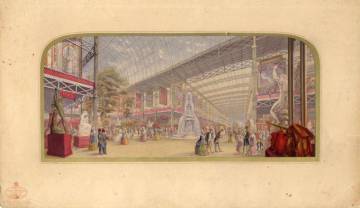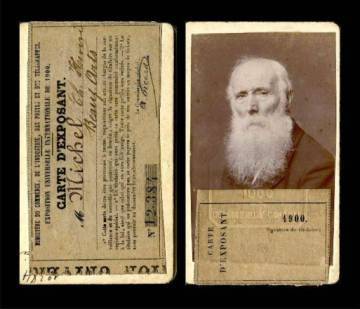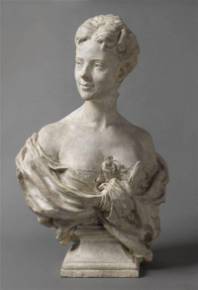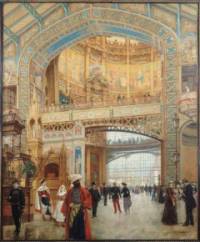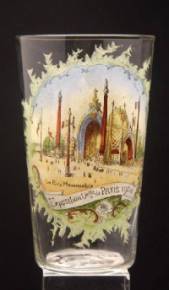Expositions universelles
Les expositions dites "universelles" furent créées pour présenter, en pleine révolution industrielle, la vitrine technique et artistique de différentes nations. Voici une découverte des collections mises en ligne par les musées de France sur ce thème, sur Joconde, le catalogue collectif des musées de France.
Crédits : ce contenu était originellement publié sur le site Joconde. Il a été constitué en 2004, puis mis à jour en 2011, par Jeannette Ivain et Mathilde Huet du service des musées de France. Les notices des collections citées sont en ligne sur POP, plateforme ouverte du patrimoine.
Montrer le progrès aux yeux du monde
Les expositions, dites "universelles" furent créées pour présenter, en pleine révolution industrielle, la vitrine technique et artistique de différentes nations.
Ces expositions suivent les préconisations définies par le Bureau international des expositions (BIE) créé en 1928, qui permettent de bien distinguer les expositions universelles des expositions plus spécialisées (coloniales, nationales, etc.).
La premier but ces grandes manifestations est de diffuser dans "un but principal d'enseignement pour le public, faisant l'inventaire des moyens dont dispose l'homme pour satisfaire les besoins d'une civilisation et faisant ressortir dans une ou plusieurs branches de l'activité humaine les progrès réalisés ou les perspectives d'avenir" (Article 1.1 de la Convention de 1928 concernant les expositions internationales, BIE).
La première exposition universelle fut organisée à Londres en 1851, à Hyde Park, au sein du Crystal Palace, conçu à cette occasion par Joseph Paxton (1801-1865).
Devant le succès de cette manifestation, de nombreux pays proposèrent alors d'organiser, à tour de rôle, des expositions identiques, visant à faire connaître à un large public la création industrielle (principalement), les arts appliqués et les beaux-arts.
Les artistes en compétition
Les œuvres exposées étaient choisies par un jury et devaient répondre à un thème proposé. La compétition y était omniprésente, et des concours permettaient aux plus méritants d'obtenir des médailles, bénéficiant d'un certain prestige.
Plus de vingt expositions universelles eurent lieu entre 1851 et 1935. Elles furent arrêtées entre 1939 et 1957. Elles ont repris depuis 1958, mais selon une fréquence désormais plus restreinte.
Œuvres exposées
Lors de ces expositions, des œuvres pouvaient faire l'objet d'achat par les États ou par des collectionneurs.
La base Joconde recense plus de 850 œuvres exposées au public parmi 16 de ces expositions universelles.
- 1851 à Londres
- 1855 à Paris
- 1862 à Londres
- 1867 à Paris
- 1873 à Vienne
- 1878 à Paris
- 1885 à Anvers
- 1889 à Paris
- 1893 à Chicago
- 1900 à Paris
- 1904 à Saint-Louis
- 1905 à Liège
- 1913 à Gand
- 1935 à Bruxelles
- 1967 à Montréal
- 1992 à Séville
Œuvres en relation
Les expositions universelles furent l'occasion de grands travaux architecturaux.
En effet, à l'origine, chaque pays disposait d'un espace réservé dans un pavillon central. Mais à partir de 1867, des pavillons nationaux (typiques de l'architecture du pays exposant), firent leur apparition.
Ces expositions universelles donnèrent également lieu à des commémorations ou à des réceptions somptueuses.
De nombreux objets (affiches, assiettes, cartes-réclame, tableaux, photographies, etc) permettent de retrouver la mémoire "visuelle" de bâtiments aujourd'hui disparus, et d'activités liées à ces manifestations.
La base Joconde en propose un certain nombre.
Liste des expositions universelles ayant eu lieu entre 1851 et 2010
- 1851 : Londres
- 1855 : Paris
- 1862 : Londres
- 1867 : Paris
- 1873 : Vienne
- 1878 : Paris
- 1880 : Melbourne
- 1888 : Barcelone
- 1889 : Paris
- 1893 : Chicago
- 1894 : Anvers
- 1897 : Bruxelles
- 1900 : Paris
- 1904 : Saint-Louis
- 1905 : Liège
- 1906 : Milan
- 1909 : Nancy
- 1911 : Charleroi
- 1913 : Gand
- 1915 : San Francisco
- 1929 : Barcelone
- 1933 : Chicago
- 1935 : Bruxelles
- 1958 : Bruxelles
- 1967 : Montréal
- 1970 : Osaka
- 1992 : Séville
- 2000 : Hanovre
- 2010 : Shanghai
- 2015 : Milan
- 2020 : Dubaï
Partager la page
